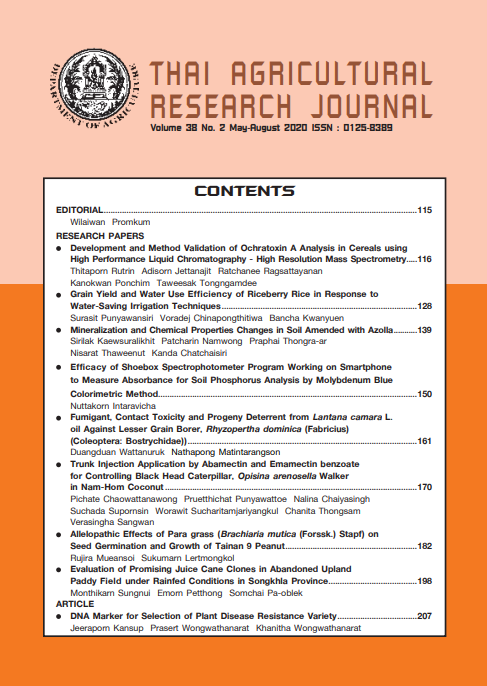Allelopathic Effects of Para grass (Brachiaria mutica (Forssk.) Stapf) on Seed Germination and Growth of Tainan 9 Peanut
DOI:
https://doi.org/10.14456/thaidoa-agres.2020.14Keywords:
Para grass, Allelopathic, Seed germination, Seedling growth, Tainan 9 peanutAbstract
The study on allelopathic effects of para grass on the seed germination and seedling growth of Tainan 9 peanut was carried out from May, 2018 to September 2019. It aims at investigating the efficacy of 4 solvents; hexane, dichloromethane, methanol and distilled water in extracting the crude yields of allelopathic materials from both shoot and root of para grass. The highest crude extract yield was obtained by methanol at 8.78 and 6.65 % respectively. Results of the study on inhibitory effect of each crude extract with varying concentrations on seed germination and seedling growth of Tainan 9 showed that methanolic extraction expressed the highest inhibitory effects on seed germination and seedling growth. The reduction in germination percentages of peanut as affected by the para grass extracted with methanol hexane, dichloromethane, and distilled water were 38.75, 40.37, 50.62 and 51.00% respectively. Regardless of the extraction solvent, all concentrations of para grass extracts from root showed significantly higher inhibitory effect on seed germination and seedling growth than extracts from shoot. At the concentration 15 mg/ml, the para grass crude extract could inhibit seed germination, shoot length, root length and % dry weight by 47.96, 51.98, 50.27 และ 3.02% respectively. However, methanol crude extraction exhibited the strongest inhibitory effect on seed germination, shoot length, root length and % dry weight of peanut at 77.50, 81.31, 79.95 and 5.03 % respectively. Results suggested that para grass extracts contained allelopathic compounds which could inhibit seed germination and seedling growth of peanut. Due to the high extract yield obtained and severe inhibitory effect of para grass, methanol should be used as an extraction solvent if needed.
References
พิสมัย ฤทธิทิศ. 2527. ผลการแก่งแย่งและแอลลิโลพาธีของวัชพืชบางชนิดที่มีต่อถั่วเขียว.วิทยานิพนธ์ปริญญาโท. มหาวิทยาลัยเกษตรศาสตร์, กรุงเทพฯ.
สุญญตา เมฆสวัสดิ์. 2551. การจัดการวัชพืชโดยใช้กิจกรรมทางอัลลิโลพาธีของหญ้าโขย่ง. วิทยานิพนธ์ปริญญาโท. มหาวิทยาลัยเกษตรศาสตร์, กรุงเทพฯ.
อินทิรา ขูดแก้ว. 2559. ผลทาง allelopathy ของวัชพืชบางชนิดต่อการงอกและการเติบโตของผักกาดหอม (Lactuca sativa L.). แก่นเกษตร. 44 (1) (พิเศษ) : 771-776.
อินทิรา ขูดแก้ว, กนกรัตน์ บุญรักษา และปรียานุช สำลี. 2559. ผลของสารสกัดหยาบจากไมยราบและหญ้าขนต่อการงอกและการเติบโตของต้อยติ่ง. แก่นเกษตร . 44 (1) (พิเศษ) : 777-782.
อัญชลี จาละ และ อมรทิพย์ วงค์สารสิน. 2556. ผลของสารอัลลีโลพาทีจากต้อยติ่งที่มีต่อการงอกของเมล็ดไมยราบผักเสี้ยนผีและผักโขมหิน. วารสารวิทยาศาสตร์และเทคโนโลยี 21.(6) (ฉบับพิเศษ): 558-564.
อุไร เพ่งพิศ. 2539. ผลของสารอัลลิโลพาธิกของวัชพืชบางชนิดที่มีผลต่อการเจริญเติบโตและผลผลิตถั่วเหลืองพันธุ์ สจ.4. วิทยานิพนธ์ปริญญาโท, มหาวิทยาลัยเกษตรศาสตร์.
Chou, C.H. and C.C. Young. 1975. Phytotoxic substances in twelve subtropical grasses. J. Chem. Ecol. 1: 183-193.
Chung, I.M., J.K. Ahn and S.J. Yun. 2001. Assessment of allelopathic potential of barnyardgrass (Echinochloa crus-galli) on rice (Oryza sativa L.) cultivars. Crop Protection 20: 921-928.
Chung, I.M , K.M. Kim, J.K. Ahn, S.B.Lee, S.H.Kim and S.J.Hahn. 2003. Comparison of allelopathic potential of rice leaves, straw and hull extracts on barnyardgrass. Agronomy Journal. 95: 1063-1070.
Coolbear, P., A. Francis and D. Grierson. 1984. The effect of low temperature pre-sowing treatment under the germination performance and membrane integrity of artificially aged tomato seeds. J. Exp. Bot. 35: 1609-1617.
Einhellig, F.A. 1987. Interactions among allelochemicals and other stress factors of the plant environment, pp. 343 - 357. In G.R. Waller, ed. Allelochemicals: Role in Agriculture and Forestry. ACS Symp. Ser. 330, Amer. Chem. Soc., Washington, D.C.
ISTA. 1996. International Rules for Seed Testing: Rule 1996. International Seed Testing Association. Zurich, Switzerland
Macias F.A., N. Chinchilla, R.M. Varela and J.M. Molinillo. 2006. Bioactive steroids from (Oryza sativa L.). Steroids. 71: 603-608.
Muenscher, W.C. 1955. Weeds. 2nd ed. The Macmillan Company, New York.
Putnam, A.R. and C.S. Tang. 1986. The Science of Allelopathy. Reproduction and Ecophysiology. 1: 322-348.
Rice, E.L.1974. Allelopathy. Academic Press, New York.
Rice, E.L.1979. Allelopathy - An update. The Botanical Review. 45: 15-109.
Rice, E.L. 1984. Allelopathy. Academic Press, Inc., Orlando. Journal. 93: 16-20.
Singh, C.M., D.R. Batish and R.K. Kohli. 2002. Allelopathic effect of two volatile monoterpenes aginst bill goat weed (Ageratum conyzoides L.). Crop Protection 21: 347-350.
Waller, G.R. 1983. Frontiers of allelochemi cals research, pp. 1-25. In C.H. Chou and G.R. Waller, eds. Allelochemicals and Pheromones. Academia Sinica Monograph Ser. No.5, Acad. Sinica, Taipei, ROC.
Zimdahl, R.L. 1999. Fundamentals of weed Science. Academic Press, California
Downloads
Published
How to Cite
Issue
Section
License
Thai Agricultural Research Journal



